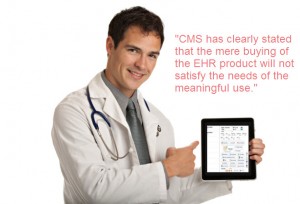 EHR has been around for more than 15 years now, but only in the last couple of years has there been an active and conscious move towards adoption. The impetus was provided by the ARRA Act that incentivized the adoption and implementation of the EHR in Clinical practices. Though the deadline for implementation is 2015, clinical informatics confirms that more than 50% of the surveyed healthcare professionals are already using EHR for their practice and more than 90% of them are happy and as adept at using the EHR as they were with the paper SuperBills. But, does this mean that the Practices are complying fully and satisfying the main objectives of the incentive plan for EHR adoption? The answer to that question is self-evident. Moreover, just implementing the EHR is beneficial to the Providers to a small extent, but does not meet with the final objectives of either the ARRA Act or CMS. EHR shouldn’t be implemented out of the fear of getting penalized (after 2015) or for the sake of incentives. EHR should be considered as an aid that makes the delivery of healthcare effective. CMS has clearly stated that the mere buying of the EHR product will not satisfy the needs of the meaningful use.
EHR has been around for more than 15 years now, but only in the last couple of years has there been an active and conscious move towards adoption. The impetus was provided by the ARRA Act that incentivized the adoption and implementation of the EHR in Clinical practices. Though the deadline for implementation is 2015, clinical informatics confirms that more than 50% of the surveyed healthcare professionals are already using EHR for their practice and more than 90% of them are happy and as adept at using the EHR as they were with the paper SuperBills. But, does this mean that the Practices are complying fully and satisfying the main objectives of the incentive plan for EHR adoption? The answer to that question is self-evident. Moreover, just implementing the EHR is beneficial to the Providers to a small extent, but does not meet with the final objectives of either the ARRA Act or CMS. EHR shouldn’t be implemented out of the fear of getting penalized (after 2015) or for the sake of incentives. EHR should be considered as an aid that makes the delivery of healthcare effective. CMS has clearly stated that the mere buying of the EHR product will not satisfy the needs of the meaningful use.
The agenda behind EHR implementation is to have a de-centralized but inter-operable system for streamlining healthcare delivery and improving quality of care thereby serving patients better. This is achieved through the inter-operability that exists between the Scheduler, EHR, e-prescribing tool, Medical Billing software and the ability to receive lab and/or radiology reports. The EHR is also designed to enable greater portability of patient information with enhanced security. The advantages for CMS is the ability to easily cull data from Providers across the country and process it into actionable information. A classic example would be something like data about the mean age of onset of diseases partially attributed to lifestyle like Diabetes Mellitus. With this data, CMS can convert it into actionable information for preventative healthcare guidelines and suggest a rewarding mechanism for patients in the form of ‘credits’ in their next premiums.
Let us discuss the major requirements of ’Meaningful Use‘:
- Buying of a certified EHR with customizable templates and supports inter-operability with other systems like e-prescribing, medical billing software etc,
- Effective use of clinical decision support like the Coding suggestions, Level of care suggestions in E/M procedures etc.
- Recording the observations for future use
- Use EHR for collecting the healthcare statistics in order to report to CMS and other Healthcare entities like the CDC for improving quality of care.
- Securing the electronic information from any data leakage.
The EHR also has the capability of simplifying the whole Medical Billing process:
Since documentation plays such an important part in Claims being paid faster, EHR are actually designed to prompt and guide a Provider with key steps during the consultation. The Provider has the choice to ignore these recommendations, but in most instances the adoption of the EHR has actually increased the ‘first pass rates’ of the claims.
Most of the EHR available today also come bundled with its own PMS. This ensures that some of the data entry functions are now automated since the data that is entered at the ‘Point of Service’ or during the encounter just flows seamlessly into the PMS.
Most EHRs also come bundled with CAC tools and CCI edits that either partially auto code based on the data entered by the Provider or prompt him with a choice of the most appropriate codes.
The combination of the EHR-PMS bundle is directly integrated with a Clearing house and at the click of a button, claims are transmitted to the Payer.
The EHR-PMS is also able to handle the inbound ERAs and some of the higher versions have auto cash-posting abilities as well.
All these features of the EHR-PMS combo makes the entire medical billing process much simpler with manual intervention required only for Audits and for AR follow-up/Denial Management. This ensures that the claims are paid faster, more consistently with minimal denials.
To conclude, it should be remembered that the EHR is a tool. As with any tool, it is only as powerful as the skill level of the user. If properly integrated and utilized, the EHR has the potential to offer some major advantages and savings to the Healthcare industry.
